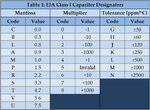By Joshua Israelsohn
Ceramics comprise the most widely used non-polarized dielectrics. The reason is they offer attractive combinations of volumetric efficiency, manufacturability, and cost. Some applications -- such as high-frequency RF signal chains and high-precision measurement circuits -- take advantage of the parametric performance available from other dielectrics, but currently available ceramic formulations perform well in a wide range of power interface, signal coupling, filtering, and timing circuits.
table, EIA class I cap designationsCeramic capacitors provide a coded nameplate designation that identifies not just capacitance and maximum working voltage. In addition, it specifies capacitor thermal behavior in conformance to EIA (Electronic Industries Alliance) standard 198. The standard divides capacitor thermal performance into three classes.

Class I devices are characterized by their tempcos (temperature coefficients of capacitance), which range in seven designations from ±30 ppm/°C to ±2,500 ppm/°C. Ceramic formulations with such low variation over temperature tend to exhibit low dielectric constants and, therefore, do not provide nearly the volumetric efficiency of ceramics for Class II capacitors. Their temperature stability makes them attractive for filtering and timing applications but such precision isn’t necessary for power-supply bypassing where lower cost per unit capacitance and greater volumetric efficiency makes Class II dielectrics more practical.
Class II devices cover a large range of thermal behaviors. Designers should consider the full range of use-cases for their products before selecting the characteristics for bypassing applications. For example, some OEMs have used capacitors with Z ratings (+10°C low-temperature limit) for decades in consumer, small office/home office, and some light-duty commercial products. But the trend away from stationary product installations means that a system’s operating environment is far less predictable than it once was. And with the growing IoT sector, there's a higher probability of blowing past Z-rated capacitors’ lower operating-temperature limit.
class 2 and 3 cap designationsSimilarly, bypass capacitors for consumer applications often have exhibited large swings in capacitance over their operating temperature range. Z5U dielectrics, for example, can lose more than half their room-temperature capacitance over their comparatively narrow operating temperature range. As we push functional electronics harder and harder, providing rock-solid power rails becomes ever more important. Skimping on bypass capacitors may save a few pennies but can risk product performance in ways that are difficult to diagnose.
Temperature isn’t the only operating condition that affects the capacitance of ceramic devices. Applied voltage does as well. Alas, ceramic capacitors’.... Read more on Power Electronics Tips.
Ceramics comprise the most widely used non-polarized dielectrics. The reason is they offer attractive combinations of volumetric efficiency, manufacturability, and cost. Some applications -- such as high-frequency RF signal chains and high-precision measurement circuits -- take advantage of the parametric performance available from other dielectrics, but currently available ceramic formulations perform well in a wide range of power interface, signal coupling, filtering, and timing circuits.
table, EIA class I cap designationsCeramic capacitors provide a coded nameplate designation that identifies not just capacitance and maximum working voltage. In addition, it specifies capacitor thermal behavior in conformance to EIA (Electronic Industries Alliance) standard 198. The standard divides capacitor thermal performance into three classes.
Class I devices are characterized by their tempcos (temperature coefficients of capacitance), which range in seven designations from ±30 ppm/°C to ±2,500 ppm/°C. Ceramic formulations with such low variation over temperature tend to exhibit low dielectric constants and, therefore, do not provide nearly the volumetric efficiency of ceramics for Class II capacitors. Their temperature stability makes them attractive for filtering and timing applications but such precision isn’t necessary for power-supply bypassing where lower cost per unit capacitance and greater volumetric efficiency makes Class II dielectrics more practical.
Class II devices cover a large range of thermal behaviors. Designers should consider the full range of use-cases for their products before selecting the characteristics for bypassing applications. For example, some OEMs have used capacitors with Z ratings (+10°C low-temperature limit) for decades in consumer, small office/home office, and some light-duty commercial products. But the trend away from stationary product installations means that a system’s operating environment is far less predictable than it once was. And with the growing IoT sector, there's a higher probability of blowing past Z-rated capacitors’ lower operating-temperature limit.
class 2 and 3 cap designationsSimilarly, bypass capacitors for consumer applications often have exhibited large swings in capacitance over their operating temperature range. Z5U dielectrics, for example, can lose more than half their room-temperature capacitance over their comparatively narrow operating temperature range. As we push functional electronics harder and harder, providing rock-solid power rails becomes ever more important. Skimping on bypass capacitors may save a few pennies but can risk product performance in ways that are difficult to diagnose.
Temperature isn’t the only operating condition that affects the capacitance of ceramic devices. Applied voltage does as well. Alas, ceramic capacitors’.... Read more on Power Electronics Tips.
